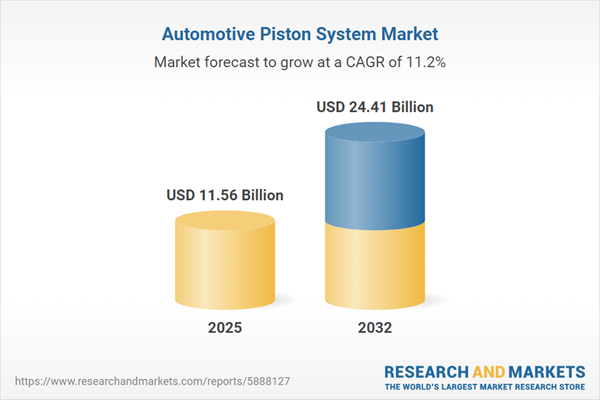Speak directly to the analyst to clarify any post sales queries you may have.
Senior decision-makers navigating the automotive piston system market must balance organizational strategy with regulatory developments, shifting technical requirements, and dynamic customer needs. The ability to anticipate and respond to market change is essential, as ongoing regulatory pressures and innovation demands create a complex landscape.
Market Snapshot: Automotive Piston System Market
The global automotive piston system market is experiencing steady growth, shaped by recurring demand in both passenger and commercial vehicle segments. As regulatory environments shift and sustainability objectives take priority, industry participants are recalibrating operations and making targeted investments in technology advancement. Companies are committing resources to enhanced materials and innovative design approaches, demonstrating active adaptation to compliance and efficiency imperatives. The continued focus on process optimization, with an eye toward long-term competitiveness, underscores a market landscape that values agile integration of new technologies, rigor in resource planning, and readiness for economic fluctuation across key regions.
Scope & Segmentation of the Automotive Piston System Market
This research provides detailed segmentation and market structure analysis, designed to support strategic decision-making and operational insights for leadership teams. The report addresses the following essential aspects of the automotive piston system market:
- Vehicle Types: Analysis covers commercial vehicles, hatchbacks, sedans, and SUVs, with attention to the unique requirements and consumer trends shaping each category in different regional contexts.
- Engine Types: Assessment compares market dynamics across diesel, gasoline, natural gas, and hybrid powertrains, illustrating their alignment with region-specific energy policies and emissions standards.
- Material Types: Evaluation of aluminum alloy, cast iron, and steel—focused on durability, accelerated product development cycles, and their role in enabling advanced propulsion technologies.
- Distribution Channels: Overview of original equipment manufacturer (OEM) and aftermarket supply networks, with emphasis on production assembly, parts availability, and logistics optimization.
- Piston Designs: Comparative insights into cast, forged, and slipper piston architectures, outlining implications for regulatory compliance and manufacturing efficiency on a global scale.
- Regional Coverage: Strategic guidance on the Americas, Europe, Middle East and Africa, and Asia-Pacific, with an emphasis on how regulatory requirements and supply chain infrastructure shape regional competitiveness and expansion strategies.
- Key Companies Profiled: Profiles highlight technical innovation and market leadership at organizations such as Art-Serina Piston Co. Ltd., Atrac Engineering Company, Continental AG, Honda Foundry (Asian) Co. Ltd., Mahle GmbH, Piston Group, and Rheinmetall AG—supporting executive benchmarking and partner evaluation.
Key Takeaways for Senior Decision-Makers
- Advancements in materials and piston design are crucial for enhancing operational longevity, meeting international benchmarks, and strengthening enterprise positioning within the global supply chain.
- Evolving emissions and sustainability directives require increased commitment to research and development, driving technical innovation and closer collaboration with strategic suppliers.
- Growing adoption of hybrid and mild hybrid vehicle platforms introduces added manufacturing complexity, prompting the need for flexible planning and decisive allocation of resources across production ecosystems.
- Implementing sustainable sourcing and holistic material management strategies improves operational coherence across diverse geographies, optimizing procurement and manufacturing processes.
- Embracing regionalization, such as nearshoring, increases resilience and supply chain stability, reducing vulnerabilities tied to localized disruptions and better aligning logistics with evolving regional structures.
Impact of U.S. Tariffs on Supply Chains
Recent changes to U.S. tariffs are reshaping the cost base of the automotive piston system supply chain. Leading companies now prioritize localized and regional production strategies as a tactical response, reinforcing supplier relationships and ensuring business continuity despite ongoing regulatory uncertainty. These approaches help safeguard timely deliveries and protect operational resilience amid global trade shifts.
Methodology & Data Sources
The report’s findings are based on direct interviews with OEMs, tiered suppliers, and key distributors, supported by comprehensive secondary research using industry literature, technical publications, and patent analytics. This rigorous methodology ensures insights are current, relevant, and actionable for executive decision-making.
Why This Report Matters
- Delivers senior executives actionable intelligence to manage technology, compliance, and operational challenges while identifying growth opportunities within the automotive piston system market.
- Enables supply chain and operations leaders to devise adaptive strategies for overcoming regional regulatory and logistics barriers across multi-market supply networks.
- Guides product development teams with up-to-date insights on material and design trends, ensuring organization-wide agility in response to customer and compliance shifts.
Conclusion
This research equips organizational leaders with clear directives to shape strategic priorities, drive agile planning, and strengthen resilience as the automotive piston system market undergoes transformative change.
Additional Product Information:
- Purchase of this report includes 1 year online access with quarterly updates.
- This report can be updated on request. Please contact our Customer Experience team using the Ask a Question widget on our website.
Table of Contents
3. Executive Summary
4. Market Overview
7. Cumulative Impact of Artificial Intelligence 2025
Companies Mentioned
The companies profiled in this Automotive Piston System market report include:- Art-Serina Piston Co., Ltd.
- Atrac Engineering Company
- Capricorn Automotive Ltd.
- Continental AG
- CP Pistons Carrillo Industries, Inc.
- Diamond Racing Pistons
- Egge Machine Company
- Gibtec Pistons
- Hastings Manufacturing Company
- Hi-Standard Machining Company
- Hitachi, Ltd.
- Honda Foundry (Asian) Co., Ltd.
- Indian Piston Limited
- ItalianRP SRL
- Mahle GmbH
- Maxiforce Inc.
- Piston Group
- RaceTec Pistons
- Rheinmetall AG
- Riken Corporation
- Ross Racing Piston
- Shriram Piston & Rings Ltd.
- Tenneco, Inc.
- Wossner Pistons
Table Information
| Report Attribute | Details |
|---|---|
| No. of Pages | 185 |
| Published | November 2025 |
| Forecast Period | 2025 - 2032 |
| Estimated Market Value ( USD | $ 11.56 Billion |
| Forecasted Market Value ( USD | $ 24.41 Billion |
| Compound Annual Growth Rate | 11.1% |
| Regions Covered | Global |
| No. of Companies Mentioned | 25 |









